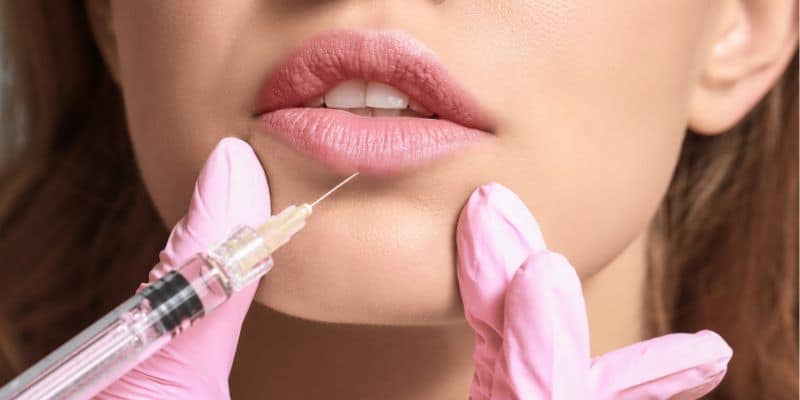
Lip augmentation continues to gain popularity as a minimally invasive cosmetic procedure to enhance or restore the shape and volume of the lips. The rapidly advancing field of dermal fillers has significantly contributed to this trend, offering a wide array of products tailored to meet patient expectations and preferences. This procedure’s success heavily relies on the choice of filler, especially for those patients embarking on their first cosmetic medicine journey.
It’s important to keep in mind key items such as what the patient wants to achieve, their health history, how long the filler lasts, and potential side effects when picking the best dermal filler. The next parts of this article are going to dig into these factors, providing an in-depth look at the popular dermal fillers that are used for lip enhancement.
Understanding Dermal Fillers
Dermal fillers are a crucial component of aesthetic medicine, used for various cosmetic procedures, including lip augmentation. The ability to reshape, add volume, and redefine lips with non-surgical interventions makes dermal fillers a preferred choice for many patients seeking subtle to significant changes in their appearance.
Dermal fillers are gel-like substances injected into the skin. They function by restoring lost volume, smoothing lines, softening creases, or enhancing facial features such as lips. The fillers can have a variety of compositions, each having unique characteristics that make them better suited for specific applications.
A vital ingredient commonly found in many dermal fillers is hyaluronic acid (HA). A naturally occurring substance in the body, hyaluronic acid helps keep the skin hydrated and voluminous. HA-based dermal fillers are widely used because they offer a natural look and feel, provide temporary results—making them a safer option for first-time patients—and are reversible if the patient isn’t satisfied with the outcome.
Calcium hydroxylapatite (CaHA) is another ingredient used in certain dermal fillers. It is a naturally occurring substance in our bones. When used in fillers, microscopic calcium particles are suspended in a smooth gel. The consistency of a CaHA filler is typically thicker than that of a hyaluronic acid filler and tends to last longer too.
Poly-L-lactic Acid is a biocompatible, biodegradable synthetic substance that is used in a different type of dermal filler—known as a collagen stimulator. Rather than providing immediate volume, this filler works over time by stimulating the skin to produce more collagen.
Understanding the composition and specific applications of these fillers is crucial to achieving the desired results in lip augmentation. The selection of a filler is not one-size-fits-all; rather, it should be customized based on the patient’s health history, aesthetic goals, and the doctor’s clinical judgment. Understanding the underlying science of dermal fillers is an essential tool in the doctor’s toolkit to guide patients towards safe and satisfying outcomes. Let’s take a deeper look at these different types now.
Types of Dermal Fillers and Their Applications
Understanding the various dermal filler options is crucial for clinicians in order to guide their patients towards the most suitable options for lip augmentation. This section delves into various types of dermal fillers, with a focus on their composition, popular brands, and the advantages and disadvantages they offer, particularly for first-time patients.
1. Hyaluronic Acid Fillers
Hyaluronic acid (HA) fillers are widely used in aesthetic practices due to their biocompatibility, reversibility, and immediate visible results. As a naturally occurring substance in the skin, HA attracts and binds water, helping to hydrate and volumize the tissue.
Popular brands of HA fillers include Juvederm and Restylane, which offer a range of products varying in viscosity and cross-linking, to cater to different degrees of lip enhancement. For instance, Juvederm Ultra offers a soft and subtle enhancement, while Juvederm Ultra Plus provides a more dramatic volumization.
The main advantage of HA fillers, especially for first-time patients, lies in their reversibility. In the event of an undesirable result or an allergic reaction, an enzyme known as hyaluronidase can dissolve the filler. Side effects, such as swelling or bruising, are generally mild and temporary. However, overcorrection, irregularities, or nodules may occur if not carefully administered.
2. Calcium Hydroxylapatite Fillers
Calcium Hydroxylapatite (CaHA) fillers, like Radiesse, are made up of tiny, almost microscopic, calcium particles suspended in a smooth gel. CaHA has been widely used in medicine for decades and is known for its safety profile.
Radiesse is the primary brand in this category. It stimulates collagen production, thereby offering a dual action of immediate volumization and progressive enhancement over time. While this makes it an interesting option, it’s generally less recommended for first-time lip augmentation patients due to its semi-permanent nature and potential for a firmer result, which may feel unnatural in a highly mobile area like the lips.
3. Poly-L-lactic Acid Fillers
Poly-L-lactic acid (PLLA) fillers, such as Sculptra, are biocompatible, biodegradable synthetic substances. Rather than giving immediate results, PLLA fillers stimulate the body’s collagen production over time.
Sculptra is the mainstay PLLA filler. While its gradual and more natural-looking results can be an advantage, this also requires patience from the patient and a series of treatment sessions. Additionally, while Sculptra has been used successfully off-label for lip augmentation, it’s primarily indicated for volume loss in the face, and thus not typically the first choice for lips.
Choosing the Right Filler for First-Time Patients
Selecting an appropriate dermal filler for first-time patients planning to undergo lip augmentation is a multi-faceted task that hinges on numerous considerations. These range from understanding the patients’ expectations and desired results, their medical history and any potential allergies, to the duration of the desired effect and the possible side effects and risks of different dermal fillers.
Understanding Patient’s Expectations and Desired Results
At the forefront of this decision-making process lies the task of thoroughly understanding the patient’s expectations and desired outcomes. Some patients may seek a subtle enhancement, while others might be aiming for a more dramatic transformation. The intensity of the desired effect will significantly influence the choice of the filler. Hyaluronic acid fillers, like Juvederm or Restylane, are known for their ability to provide varying degrees of volume based on their specific formulation and the injection technique employed. Conversely, poly-L-lactic acid fillers (like Sculptra) stimulate the body’s collagen production for a more gradual and natural-looking result, suitable for patients seeking less pronounced changes.
Patient’s Health History and Allergies
A thorough assessment of the patient’s medical history and potential allergies is a crucial step that must not be overlooked. Some patients might show sensitivity to specific filler components. For instance, those allergic to lidocaine, a common ingredient in many fillers to aid in pain relief during the injection, should steer clear of fillers containing this local anesthetic. Likewise, patients with a history of severe allergies, multiple severe allergies, or patients with a history of anaphylaxis should exercise caution when considering dermal fillers. Hyaluronic acid fillers are typically well tolerated, given that hyaluronic acid naturally occurs in the body, reducing the risk of an allergic reaction.
Duration of Effect
The expected longevity of the results is another crucial factor. If a first-time patient is unsure about how they will feel about their augmented lips, a filler with a shorter lifespan might be preferable. In this regard, hyaluronic acid fillers offer an advantage as their effects typically last between 6-12 months, and are also reversible if the patient is dissatisfied with the results. This makes them a safer choice for first-timers compared to more permanent fillers like Polymethylmethacrylate (PMMA) fillers.
Potential Side Effects and Risks
Each type of dermal filler carries potential side effects and risks. While minor side effects like swelling, redness, and bruising at the injection site are common with most fillers, some more severe reactions might occur, albeit rarely. These could include lumps and bumps, skin discoloration, and even more severe complications like infection or vascular occlusion. As a general rule, the risk of severe complications is less with temporary fillers like hyaluronic acid fillers, compared to more permanent options.
Expert Recommendations
For first-time patients, hyaluronic acid fillers often emerge as the most recommended choice. This preference is primarily due to their proven safety profile, the temporary and reversible nature of their results, and their flexibility in providing different degrees of lip volume based on the patient’s aesthetic goals. These fillers are also compatible with ‘staged’ treatments, which can be ideal for first-timers. This involves injecting smaller amounts of filler over several sessions, allowing patients to adjust gradually to their new appearance. This approach is ideal for patients who aren’t certain how dramatic an enhancement will suit them.
Procedure and Post-Procedure Care
The meticulous approach to the lip augmentation procedure and post-procedure care is of utmost importance in achieving desired outcomes while minimizing complications. This process not only guarantees the patient’s satisfaction but also preserves their trust in aesthetic procedures, which is especially critical for first-time patients.
The lip augmentation procedure begins with a thorough consultation to understand the patient’s aesthetic goals. It is essential to establish clear communication and realistic expectations. Once the type of dermal filler is decided, the treatment area is cleaned and prepped. Anesthesia, usually in the form of a topical numbing cream or a nerve block, is administered to ensure the patient’s comfort.
Following anesthesia, the dermal filler is strategically injected into the lips, typically using a fine needle or cannula. The technique of injection can vary, but linear threading, serial puncture, and cross-hatching are common methods. Special care is taken to avoid vascular compromise by adhering to safe injection techniques. Additionally, massage may be employed to distribute the filler evenly.
Post-procedure care plays an instrumental role in patient satisfaction and the longevity of the treatment’s effects. Patients should be informed about potential temporary side effects like swelling, bruising, and tenderness, which are commonly experienced after the procedure. To manage these, cold compresses can be used intermittently for the first 24 to 48 hours.
Guidelines for post-procedure care should include avoiding strenuous exercise, heat exposure, and consumption of alcohol for at least 24 hours post-treatment. These measures help in reducing the risk of increased swelling and bruising. The use of Arnica montana, a homeopathic remedy, may also be beneficial to hasten the resolution of bruising if it occurs.
Importantly, patients should be informed not to manipulate the treated area for the first few hours post-treatment to prevent filler displacement. A follow-up appointment is typically scheduled within two weeks of the procedure. This allows the doctor to assess the final result once the swelling has fully resolved and make any necessary adjustments.
Through these steps, one can ensure the safety and satisfaction of first-time patients who opt for lip augmentation.
Conclusion
In closing, doctors have a significant responsibility in guiding first-time patients through their lip augmentation journey. With the multitude of dermal fillers available, choosing the right product for each patient is crucial. The decision should not only consider immediate aesthetic results, but also the patient’s overall health, their lifestyle, and the long-term impact of the procedure. This process involves thorough consultation, empathetic communication, and deep understanding of the different dermal fillers available. Licensed medical professionals can buy genuine dermal fillers at wholesale prices at Health Supplies Plus.

About the Author: Doris Dickson is a specialist writer for Health Supplies Plus, focusing on the aesthetic medicine industry. She diligently researches cosmetic treatments and products to provide clear, concise information relevant to licensed medical professionals. Her work supports Health Supplies Plus’s commitment to being a reliable informational resource and trusted supplier for the aesthetic community.
Disclaimer: The content provided in this article is intended for informational purposes only and is directed towards licensed medical professionals. It is not intended to be a substitute for professional medical advice, diagnosis, or treatment, nor does it constitute an endorsement of any specific product or technique. Practitioners must rely on their own professional judgment, clinical experience, and knowledge of patient needs, and should always consult the full product prescribing information and relevant clinical guidelines before use. Health Supplies Plus does not provide medical advice.

